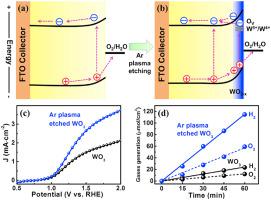当前位置:
X-MOL 学术
›
J. Phys. Chem. Solids
›
论文详情
Our official English website, www.x-mol.net, welcomes your
feedback! (Note: you will need to create a separate account there.)
Surface oxygen vacancies on WO3 nanoplate arrays induced by Ar plasma treatment for efficient photoelectrochemical water oxidation
Journal of Physics and Chemistry of Solids ( IF 4.3 ) Pub Date : 2021-02-01 , DOI: 10.1016/j.jpcs.2020.109823 Yihan Liu , Lina Kong , Xin Guo , Jianping Xu , Shaobo Shi , Lan Li
Journal of Physics and Chemistry of Solids ( IF 4.3 ) Pub Date : 2021-02-01 , DOI: 10.1016/j.jpcs.2020.109823 Yihan Liu , Lina Kong , Xin Guo , Jianping Xu , Shaobo Shi , Lan Li

|
Abstract The construction of surface defects on semiconductor oxide photoanodes has been identified as a promising route for attaining improved photoelectrochemical (PEC) performance. Here, Ar plasma treatment has been used to etch the surface of hydrothermally synthesized WO3 nanoplate array films, which generated surface oxygen vacancies (Ovs) with the concomitant reduction of surface W6+ to W5+/W4+. As a result, the visible-light absorption and photogenerated charge separation of WO3 was enhanced, as evidenced by X-ray photoelectron spectroscopy (XPS), UV/Vis diffuse-reflectance spectroscopy (DRS), and photoluminescence (PL) spectroscopy. A WO3 photoanode subjected to Ar plasma treatment for 120 s exhibited a photocurrent density of 1.32 mA cm−2 and an O2 evolution rate of 1.0 μmol cm−2·min−1 under simulated solar light irradiation at a bias potential of 1.23 V vs. reversible hydrogen electrode, approximately 1.7- and 5-times higher, respectively, than those of a pristine sample. This improvement is mainly attributed to the facilitative effect of surface oxygen vacancy defects, which promote electron–hole generation and separation rates and decrease the interfacial charge-transfer resistance between the WO3 photoanode and electrolyte. Our Ar plasma surface modification also has potential for developing other photoanodes for efficient PEC performance.
中文翻译:

Ar等离子体处理诱导WO3纳米片阵列表面氧空位有效光电化学水氧化
摘要 在半导体氧化物光阳极上构建表面缺陷已被确定为获得改进光电化学 (PEC) 性能的有希望的途径。在这里,Ar 等离子体处理已被用于蚀刻水热合成的 WO3 纳米片阵列薄膜的表面,其产生表面氧空位 (Ovs),同时表面 W6+ 还原为 W5+/W4+。结果,如 X 射线光电子能谱 (XPS)、紫外/可见漫反射光谱 (DRS) 和光致发光 (PL) 光谱所证明的那样,WO3 的可见光吸收和光生电荷分离得到增强。经 Ar 等离子体处理 120 s 的 WO3 光阳极表现出 1.32 mA cm-2 的光电流密度和 1 的 O2 析出速率。0 μmol cm-2·min-1 在偏置电位为 1.23 V 的模拟太阳光照射下与可逆氢电极相比,分别比原始样品高约 1.7 倍和 5 倍。这种改进主要归因于表面氧空位缺陷的促进作用,它促进了电子-空穴的产生和分离速率,并降低了 WO3 光阳极和电解质之间的界面电荷转移电阻。我们的 Ar 等离子体表面改性还具有开发其他光阳极以实现高效 PEC 性能的潜力。这促进了电子-空穴的产生和分离速率,并降低了 WO3 光阳极和电解质之间的界面电荷转移电阻。我们的 Ar 等离子体表面改性还具有开发其他光阳极以实现高效 PEC 性能的潜力。这促进了电子-空穴的产生和分离速率,并降低了 WO3 光阳极和电解质之间的界面电荷转移电阻。我们的 Ar 等离子体表面改性还具有开发其他光阳极以实现高效 PEC 性能的潜力。
更新日期:2021-02-01
中文翻译:

Ar等离子体处理诱导WO3纳米片阵列表面氧空位有效光电化学水氧化
摘要 在半导体氧化物光阳极上构建表面缺陷已被确定为获得改进光电化学 (PEC) 性能的有希望的途径。在这里,Ar 等离子体处理已被用于蚀刻水热合成的 WO3 纳米片阵列薄膜的表面,其产生表面氧空位 (Ovs),同时表面 W6+ 还原为 W5+/W4+。结果,如 X 射线光电子能谱 (XPS)、紫外/可见漫反射光谱 (DRS) 和光致发光 (PL) 光谱所证明的那样,WO3 的可见光吸收和光生电荷分离得到增强。经 Ar 等离子体处理 120 s 的 WO3 光阳极表现出 1.32 mA cm-2 的光电流密度和 1 的 O2 析出速率。0 μmol cm-2·min-1 在偏置电位为 1.23 V 的模拟太阳光照射下与可逆氢电极相比,分别比原始样品高约 1.7 倍和 5 倍。这种改进主要归因于表面氧空位缺陷的促进作用,它促进了电子-空穴的产生和分离速率,并降低了 WO3 光阳极和电解质之间的界面电荷转移电阻。我们的 Ar 等离子体表面改性还具有开发其他光阳极以实现高效 PEC 性能的潜力。这促进了电子-空穴的产生和分离速率,并降低了 WO3 光阳极和电解质之间的界面电荷转移电阻。我们的 Ar 等离子体表面改性还具有开发其他光阳极以实现高效 PEC 性能的潜力。这促进了电子-空穴的产生和分离速率,并降低了 WO3 光阳极和电解质之间的界面电荷转移电阻。我们的 Ar 等离子体表面改性还具有开发其他光阳极以实现高效 PEC 性能的潜力。






























 京公网安备 11010802027423号
京公网安备 11010802027423号